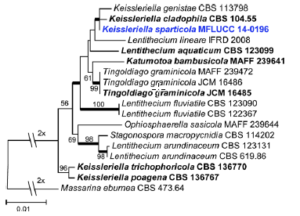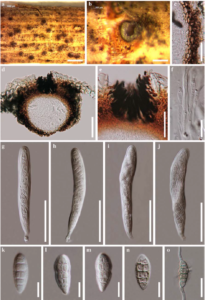Keissleriella sparticola Singtripop & K.D. Hyde.
Index Fungorum number: IF551011, Facesoffungi number: FoF00481, Fig. 2
Etymology– The species epithet refers to “Spartium sp.” the host genus.
Holotypus – MFLU 14–0116
Saprobic on a dead branch of Spartium junceum. Sexual morph Ascomata 134 – 259 μm high × 130 – 260 μm diam. (x̄ = 180 × 182 μm, n = 5), immersed in the host tissue, globose to subglobose, dark brown to black, round, dimidiate, ostiole central. Ostiole 47 – 84 μm high × 69 – 88 μm diam. (x̄ = 60 × 81 μm, n = 5), papillate, dark brown, smooth, with long, dark brown setae, with about 28 – 79 μm. Peridium 27 – 44 μm wide, thick, comprising 5 – 6 layers, outer layer comprising heavily pigmented, thick-walled, brown to dark brown cells of textura angularis, inner layer composed of hyaline, thin-walled cells of textura angularis. Hamathecium comprising numerous, 1.7 – 3.2 μm wide, filamentous, occasionally branched, septate, hyaline, pseudoparaphyses. Asci 104 – 123 × 17 – 23 μm (x̄ = 116 × 19 μm, n = 7), 8 – spored, bitunicate, broadly cylindrical, smooth-walled, with an ocular chamber. Ascospores 24 – 29 μm high × 9 – 11 μm diam. (x̄ = 27 × 10 μm, n = 10), 2 – 4 – overlapping seriate, oval to ellipsoid, with 2 layers, upper part wider than the lower part, 4 – 5 – septate, with 1 – 3 vertical septa, hyaline, becoming yellowish at maturity. Asexual morph Undetermined.
Culture characters – Colonies on PDA slow growing, reaching 0.5–1 cm diam. after 1 week at 18 °C, later with dense mycelium, circular, margin smooth, white at first, pinkish- ash after 4 weeks, Hyphae thin, smooth-walled, branched septate, hyaline. Reverse similar.
Material examined – ITALY, Ravenna Province, Monticino, Brisighella, on dead branch of Spartium junceum L. (Fabaceae), 18 September 2013, E. Camporesi IT 990 (MFLU 14–0116, holotype). ex-type culture, MFLUCC 14–0196; GenBank LSU: KP639571.
Notes – Keissleriella was introduced by Höhnel (1919) and is typified by K. aesculi Sacc (≡ Pyrenochaeta aesculi Höhn.). The genus Keissleriella is characterized by black setae in the ostiolar canal and hyaline 1 to multi-septate ascospores (Barr 1990). Based on the phylogenetic tree (Fig. 1) the new species of Keissleriella sparticola has a close relationship with Keissleriella cladophila, Keissleriella genistae, Lentithecium lineare and Lentithecium aquaticum. However our new species differ from these species in host, ascomata, periphyses, asci and/or ascospore characters (Table 1).

Table .1 Synopsis comparing Keissleriella sparticola and some related species

Fig. 1 Phylogram generated from Maximum likelihood (RAxML) analysis based on combined LSU and SSU sequence data of Lentitheciaceae. Maximum likelihood bootstrap support values greater than 50 % are indicated above or below the nodes, and branches with Bayesian posterior probabilities greater than 0.95 are given in bold. The ex-types (reference strains) are in bold; the new isolates are in blue. The tree is rooted with Massarina eburnea CBS 473.64.

Fig. 2 Keissleriella sparticola (holotype) a Appearance of ascomata on host surface b Section of ascoma on host c Peridium d Vertical section through ascoma e Close up of periphyses f Pseudoparaphyses g Immature ascus h–j Mature asci k–n Mature ascospores o Germinating ascospore. Scale bars: a = 1000 μm, b, d, e = 200 μm, c = 100 μm, g – j = 50 μm, f, o = 20 μm, k – n = 10 μm.
